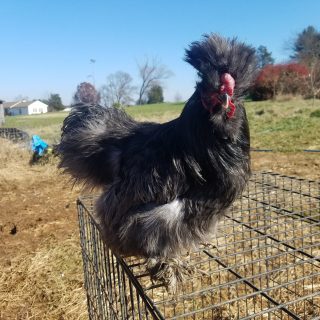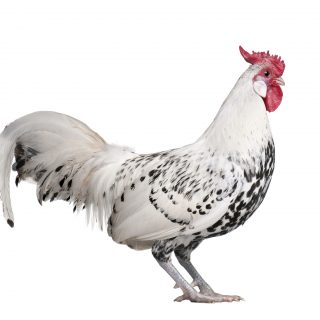Cream Legbar chickens are an interesting breed of chicken that can be easily recognized due to the strange crest of feathers that grows from their heads. These birds look like they have grown a feathery head of hair and, like the name implies, are one of the many Legbar breeds. These chickens lay blue-colored eggs and are known for being easy to handle.
The Cream Legbar chicken is an autosexing breed that lays a beautiful blue egg. They are a great choice if you are looking for a decent layer. These friendly chickens are perfect for those with little chicken-keeping experience and have quite a bit of interesting history behind them.
While this chicken isn’t really good for meat, it can live in diverse flocks, so keeping other breeds with them is easy. The Cream Legbar will lay around 180 eggs per year, and they are all a blue egg laying chicken setting them apart from your standard white and brown eggs.
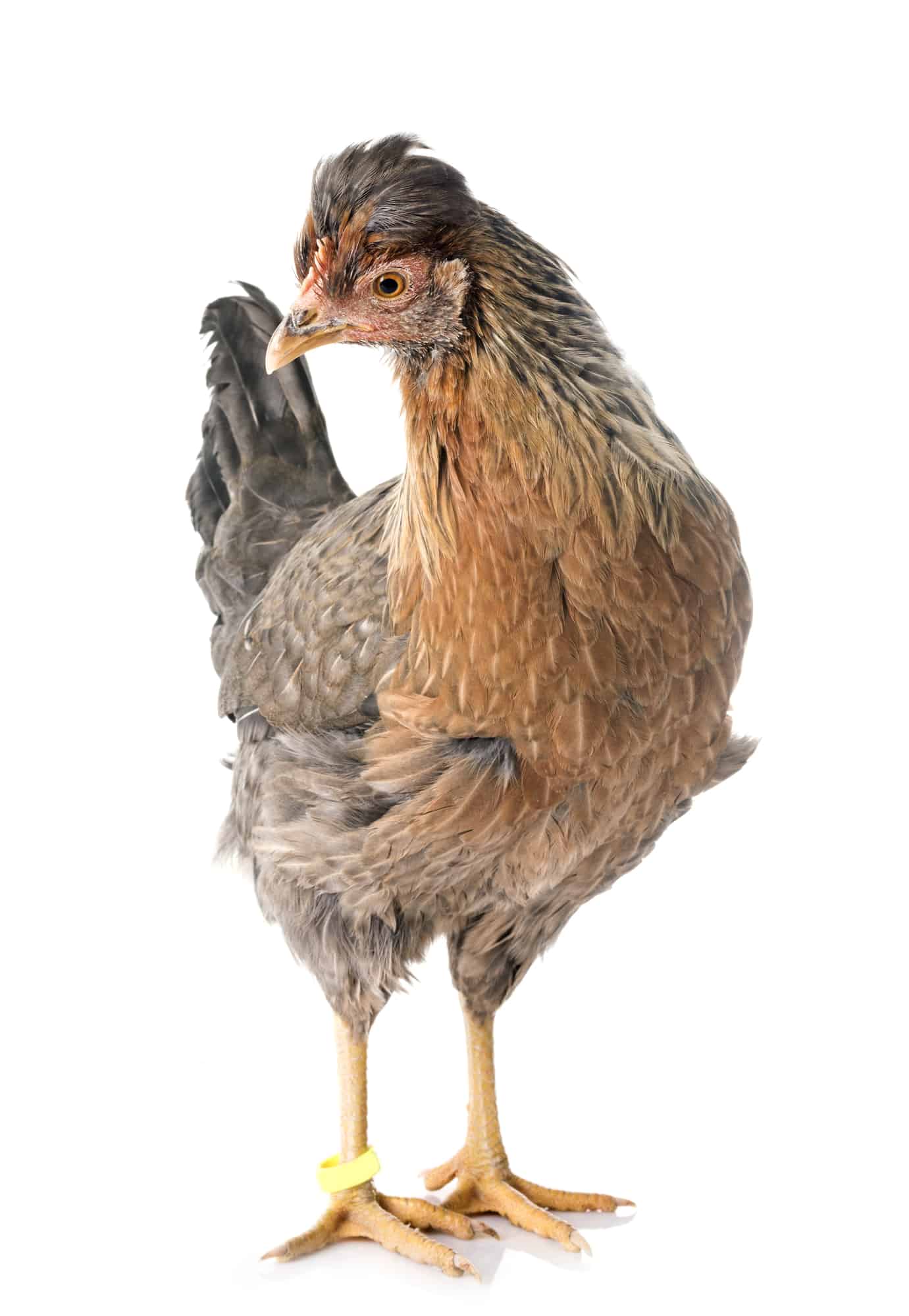
Depending on the chicken, you can expect your Cream Legbar to live between five to ten years with proper care. The breed is also auto-sexing. This means you don't need to know much about how to sex a chicken as you can tell just by their color. This is similar to the sex-linked, Sapphire Gem Chicken breed.
Sadly, this breed is rare in the United States, so you may have a bit of trouble finding a breeder at first.
If their blue eggs and quirky hairstyle appeal to you still appeal to you though, then keep reading below to learn more about the Cream Legbar Chicken.
Cream Legbar Chickens
| Size | 7.5 Pounds (Rooster) 5.5 Pounds (Hen) |
| Class | SCCL (single comb clean leg) |
| Color | Silver, Gold, Cream |
| Temperament | Docile |
| Hardiness | Hardy |
| Eggs/Yr | 180 |
| Egg Size | Medium |
| Egg Color | Blue |
[ez-toc]
History & Origin
The Cream Legbar is a British breed of chicken that was created in the 1900s by genetic researchers. They were bred at Cambridge University and came about due to crossing Leghorn chickens and Plymouth Rock chickens. As time went on, the breed was further cross-bred to gain new colors like white. Their blue eggs originate through breeding with the Spanish Araucana chicken.
By 1958 the breed finally became standardized, but interest in them started to decrease due to the fact that they laid blue eggs. By 1970, they were in danger of going extinct and even today are still under a “watch” status on the conservation list. The ability for this breed’s autosexing and the low amount of blue laying breeds available have now caused chicken enthusiasts to take more of an interest in the Cream Legbar Chickens.
Another problem facing this breed and making them rare is the fact that many of the chicks sold claiming to be Cream Legbars aren’t up to standard. While this may not be a problem for those looking for a decent layer or pet, this can cause issues with entering your chicken into shows and will likely cause your bird to be outright disqualified.
You should keep in mind that many shows in America may not accept the Cream Legbar as a competitor anyways as they haven’t yet been recognized by the APA.
What do they look like?
Like we just mentioned, you need to pay special attention to the breed standards for the Cream Legbar chicken. To begin with, the Cream Legbar has not received recognition by The American Poultry Association, but that is not the case overseas since 1958 so this is likely to change at any time. The standards listed below are from the British Poultry Club.
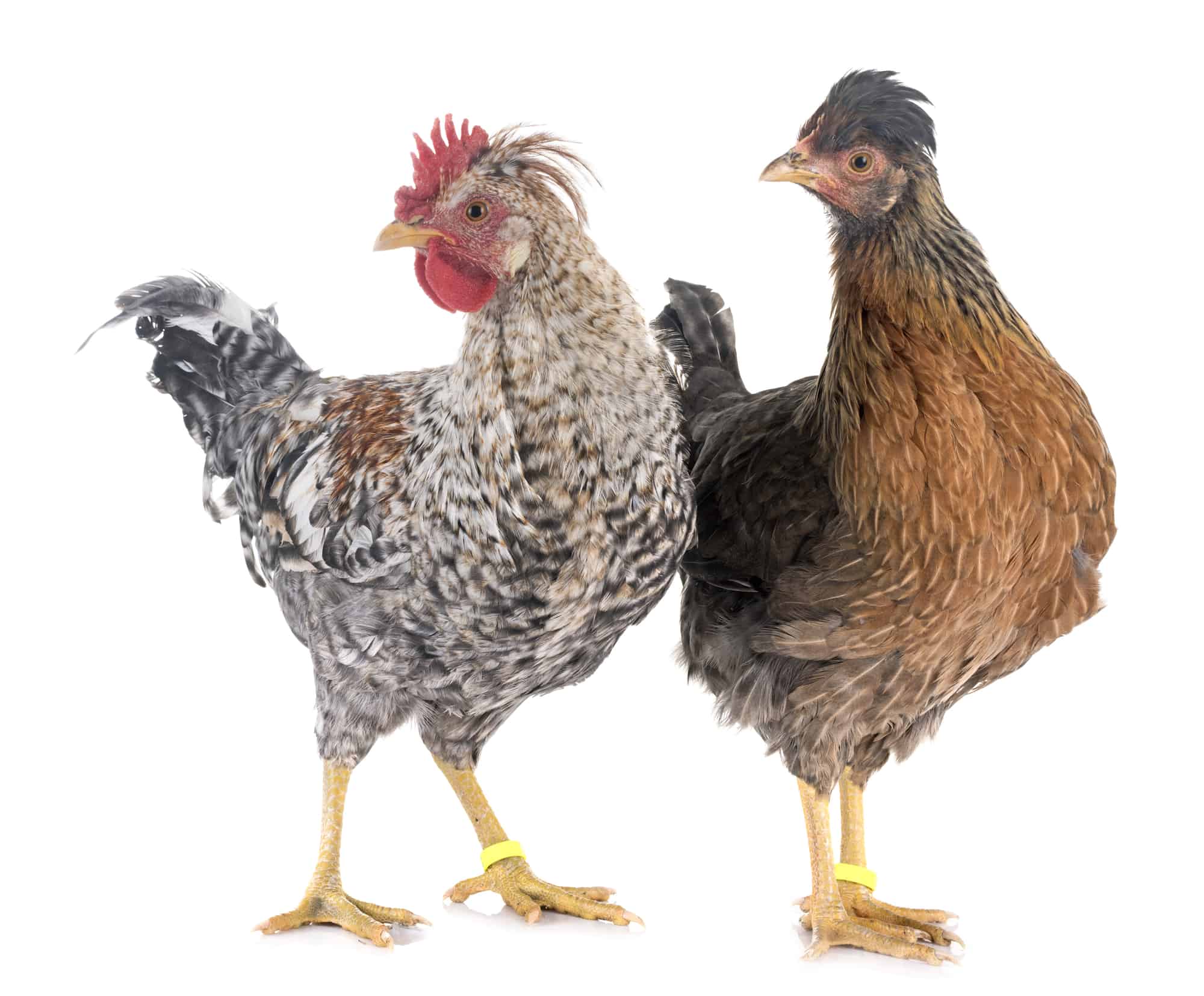
This breed will have grey and cream coloring, with barring on its body; this will be most notable on the chicken’s tail and around the neck. There are some noticeable differences between the hens and roosters. Hens will have salmon coloring on their breast and more of a grey body.
The roosters will have a cream or grey chest, wings, and legs. Hens also have wider bars on their bodies than the roosters. You will also notice that they have feathers growing out of their head that gives them the appearance that they have a tuft of hair or a small hat on.
They have bright red wattles and white earlobes. Their legs are clean with a yellow coloring, much like on their beak. Some of them are a crested chicken, but not all will have the crests.
The hens usually weigh in at around 5.5 pounds, while the roosters reach up to 7.5 pounds. Their body has a wedge shape, and they are muscular birds. Their tail goes up at an angle, and you will notice that their feathers have a silky feeling to them, not entirely unlike Silkie Chickens.
They have long wattles, with the red coloring extending into their face and a single comb on their heads. If the chicken has too much brown on it, though, then it may not befall into breed standards. You want to see a fair amount of cream coloring on the bird.
Temperament
The Cream Legbar’s temperament is a bit hard to pin down, but most importantly, they are not an aggressive breed. There seem to be two distinct temperaments that you will get when keeping the Cream Legbar.
The first is friendly temperament, meaning the chicken will interact with you, follow you, and, if handled enough, may even let you pet it.
The second temperament is a flighty one, which fits in with this breed’s superior response to predators. These Cream Legbars are easy to scare and do not like anyone touching them.
A mix of these two temperaments is also possible, and this breed seems to really vary from bird to bird. Rooster Cream Legbars on the other hand, can be a bit aggressive, especially when they are looking to mate.
The best way to get your chicken used to you is to raise them as chicks and safely handle them as they grow. While this won’t cause some chickens to be less jumpy, it can at least ease them into your presence. Then, just know how to introduce them to your existing flock.
Their chattiness may also be affected by their temperament, but there are many reports that flocks of Cream Legbars tend to be on the quieter side. This does change if they are spooked, though. They are considered to be a breed that is highly alert, allowing them to easily avoid any predators roaming around.
Cream Legbars are good free-range birds, but they have a tendency to destroy their environment. They forage well (like Dorking chickens do) but are infamous for doing so to the point that they tear up their surroundings. Building a chicken run is a great way to still let your Cream Legbars roam without digging holes all around your yard.
What is their purpose?
The purpose of the Cream Legbar is going to differ a bit depending on where you live. While there are certainly some shows you can enter them in, don’t expect to get into any major competitions until they recieve recognition by the APA.
If you happen to be reading this from overseas, though, then you may have a much easier time raising them for show. Keeping them as a pet is also possible, but just how much you can interact with your Cream Legbar can vary, especially if the Cream Legbar you pick up has a more flighty temperament.
They are good egg layers and will lay around 180 eggs a year. The eggs will be blue in color but sometimes can appear on the greener side. In addition, there have been cases of Cream Legbars laying white eggs.
If you want a chicken that lays green eggs, there are many to choose from such as Easter Eggers.
This is a breed that doesn’t lay well in the winter months, so if your primary concern is having year-round eggs, you may want to have a mixed flock. Despite common myths, blue eggs taste the same as white and brown ones do. Cream Legbars won’t provide you with a good source of meat, though, as they have muscular bodies and are a bit small.
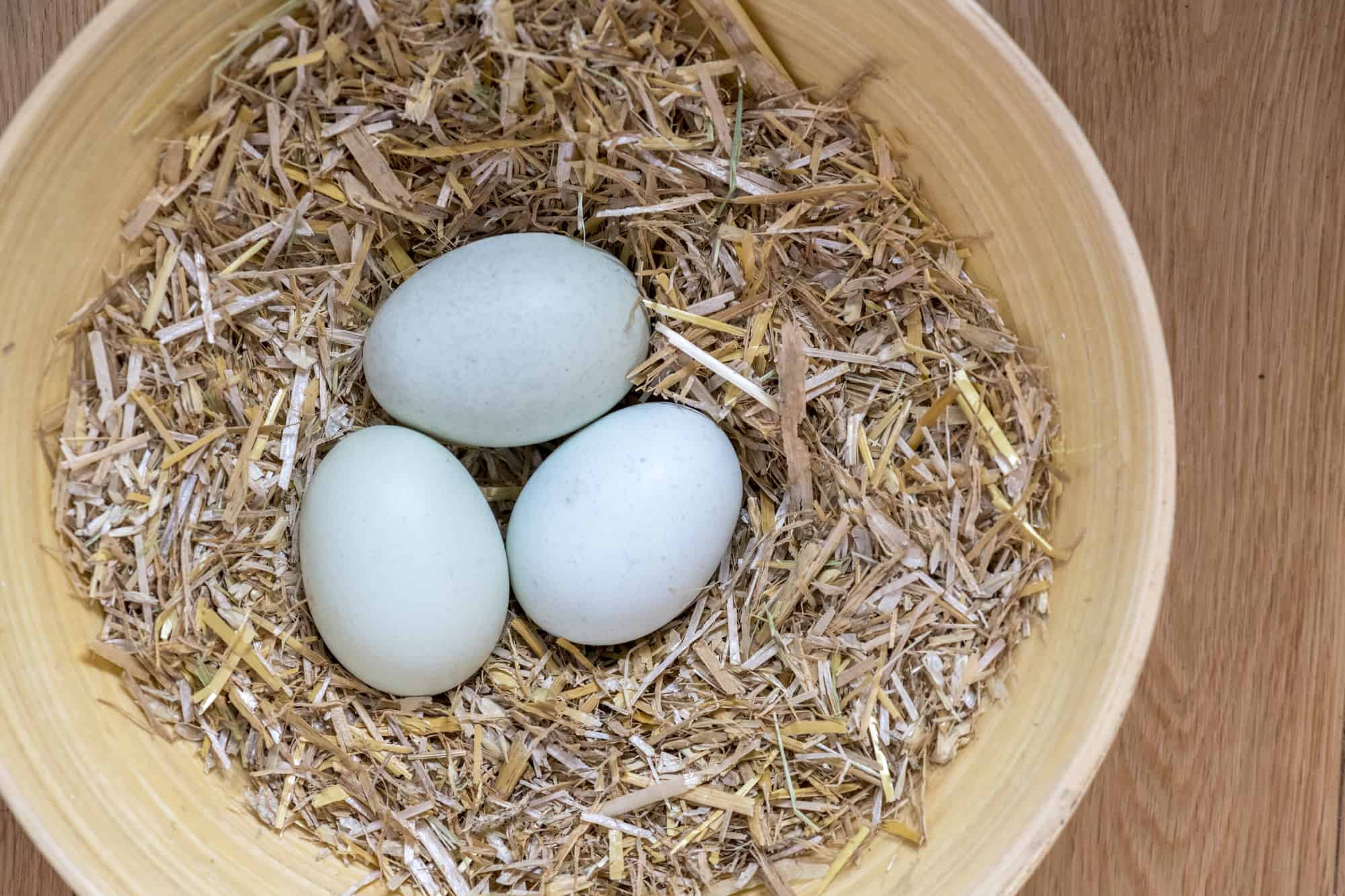
If you are planning to breed the Cream Legbar, then you will run into several different problems. Firstly, this is not a broody breed, so you can’t really expect them to take care of their eggs. You will want to have an incubator on hand to ensure the chicks are hatching.
Next, it may be hard to sell off chicks if that is your plan. Currently, there are only a handful of trusted breeders in the states, and only one of them is currently importing Cream Legbars from Britain.
Care and Health
While the Cream Legbar isn’t a one of the largest chicken breeds, they still need a roomy coop that gives them plenty of room to move around in. Due to their single comb, they are sensitive to the cold weather and can easily get frostbite on their combs. To prevent this, make sure your coop is insulated from the elements to keep the chickens warm in the winter. You will also want to consider how you want to deal with this breed of chickens, as they love to free roam.
Since the Cream Legbar are heavy foragers, they will tear up your yard without a second thought. If this is going to cause problems, then you will want to build a chicken run to help contain the damage. Be sure to have your flock on a schedule so they can know what time they are coming out of their coop.
This is especially important during the evening as they should all be put up in the evening before the sunsets. While this breed is good at avoiding predators, it’s still safe to have them all home and accounted for at the same time each day.
The Cream Legbar needs constant access to clean water. So make sure to get them one of the best chicken waterers you can .
Although they are amazing at foraging for food, you will still want to feed them each day to ensure and meet their dietary requirements. Though the average cost to feed chickens may be higher than the cost to feed this breed due to their foraging abilities.
If you do end up with a flighty flock of birds, be careful when interacting with them to keep from spooking them. This will decrease the stress in your flock, helping them to stay healthier longer.
Outside of normal issues like mites, this breed isn’t at risk for any serious health problems. Just make sure they are warm in winter and have shade in summer. You also won’t need to worry about bathing this breed as they are generally pretty self-sufficient.

FAQ
What color eggs does a Cream Legbar lay?
The Cream Legbar lays a unique blue color of egg that can sometimes look a bit more green in color than blue. Despite popular myths, the blue coloring doesn’t affect the taste of the Cream Legbars eggs.
Are Cream Legbar chickens friendly?
They are friendly chickens, but you may find that while they are happy to follow you around, petting is off the table. Some Cream Legbars tend to scare more easily than others, and some don’t like to be touched at all.
Is a Cream Legbar a bantam?
While the Cream Legbar is a small breed of chicken, they aren’t classified as Bantams.
How long do Cream Legbar chickens live?
The Cream Legbar tends to live anywhere between five to ten years. Exactly how long chickens live, of course, can differ based on the care the chicken receives.
How rare are Cream Legbar chickens?
If you live in Britain, they are slightly rare, but in America, they are an incredibly hard-to-find breed. In fact, there are only a handful of breeders scattered around the states, so getting a Cream Legbar can be pretty difficult.
Are cream Legbar chickens cold hardy?
The Cream Legbar should not be kept in the cold for long as they are a single comb breed. This means that they can get frostbite on their combs relatively easily.
How much are cream Legbar chickens?
Cream Legbar hens tend to be around $29, while roosters will cost you slightly less at around $19.
Do Cream Legbars go broody?
This is a breed that doesn’t really go broody very often. If you are planning on breeding them, then you will need to have an incubator on hand.
Are cream Legbar Roosters aggressive?
The Cream Legbar rooster can be aggressive, especially when it’s time to mate.
If you need more help with taking care of your chickens, check out The Organized Chicken Keeper for a complete system for managing their health through keeping their supplies stocked and coop clean.

